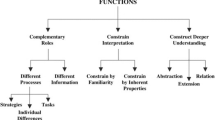Abstract
The present study investigates the effects that concreteness fading has on learning and transfer across three grade levels (4–6) in elementary school science education in comparison to learning with constantly concrete representations. 127 9- to 12-years-old elementary school students studied electric circuits in a computer-based simulation environment, where circuits remained concrete (bulbs) throughout the learning or faded from concrete to abstract (bulbs to resistors). The most important finding was that the outcomes seemed to be influenced by a developmental factor: the study found a significant interaction between condition and grade level in relation to learning outcomes, suggesting that the outcomes generally improved as a function of grade level, but that there were notable differences between the conditions regarding the improvement of outcomes across the three grades. According the results, learning with constantly concrete representations either took less time or resulted in better learning compared to concreteness fading. Because transfer is one of the central arguments for concreteness fading, a somewhat surprising finding was that the concrete condition succeeded at least as well as the fading condition on transfer tasks. The study also discusses why the results and issues related to the conceptualisation and operationalisation of central concepts in the study call for caution towards generalization and for more research with young learners across different grades.




Similar content being viewed by others
Notes
The choice for resistors as abstract representations is not evident from a formal physics point of view, whereof a resistor and a bulb are equivalent and equally concrete circuit components. The physics view, however, presupposes notable formal knowledge about the domain. Given the fact that the students had no previous formal education on electricity it is highly unlikely that they already shared such conception. This contention is backed up by results of several studies that show that students, even on a high school level, perceive bulbs and resistors differently (Jaakkola and Veermans 2015; Johnson et al. 2013; Moreno et al. 2011). An explanations for this difference, and an argument for the assertion that bulbs are more concrete than resistors, is that from a conceptual or perceptual point of view, bulbs have a clear practical purpose (to radiate light) that based on prior everyday experiences practically everyone can relate to. In contrast, the purpose of resistors to reduce current flow and divide voltages in a circuit, among many other uses, is unclear and significantly more abstract to most people.
The initial sample consisted of 134 students but only those were included in the analyses who completed all three parts of the study (pre-test, intervention, and post-test).
The students worked in pairs because working in pairs is a natural procedure in science classrooms in Finland, which at the same time ensured better comparability with the initial study that also included pairs (Jaakkola and Veermans 2015).
g is Hedges' (1981) bias corrected standardised mean difference effect size for two independent samples.
References
Ainsworth, S. (1999). The functions of multiple representations. Computers & Education, 33(23), 131–152. doi:10.1016/S0360-1315(99)00029-9.
Ainsworth, S. (2006). DeFT: A conceptual framework for considering learning with multiple representations. Learning and Instruction, 16(3), 183–198. doi:10.1016/j.learninstruc.2006.03.001.
Anderson, J. R., Reder, L. M., & Simon, H. A. (1996). Situated learning and education. Educational Researcher, 25(4), 5–11. doi:10.3102/0013189X025004005.
Braithwaite, D. W., & Goldstone, R. L. (2013). Integrating formal and grounded representations in combinatorics learning. Journal of Educational Psychology. doi:10.1037/a0032095.
Carey, S., Zaitchik, D., & Bascandziev, I. (2015). Theories of development: In dialog with Jean Piaget. Developmental Review, 38, 36–54. doi:10.1016/j.dr.2015.07.003.
Chi, M., Feltovich, P. J., & Glaser, R. (1981). Categorization and representation of physics problems by experts and novices. Cognitive Science, 5(2), 121–152. doi:10.1207/s15516709cog0502_2.
Cox, B. D. (1997). The rediscovery of the active learner in adaptive contexts: A developmental-historical analysis. Educational Psychologist, 32(1), 41–55. doi:10.1207/s15326985ep3201_4.
De Bock, D., Deprez, J., Van Dooren, W., Roelens, M., & Verschaffel, L. (2011). Abstract or concrete examples in learning mathematics? A replication and elaboration of Kaminski, Sloutsky, and Heckler’s study. Journal for Research in Mathematics Education, 42(2), 109–126.
Demetriou, A., Spanoudis, G., & Mouyi, A. (2011). Educating the developing mind: Towards an overarching paradigm. Educational Psychology Review, 23(4), 601–663. doi:10.1007/s10648-011-9178-3.
Finkelstein, N. D., Adams, W. K., Keller, C. J., Kohl, P. B., Perkins, K. K., Podolefsky, N. S., … LeMaster, R. (2005). When learning about the real world is better done virtually: A study of substituting computer simulations for laboratory equipment. Physical Review Special Topics—Physics Education Research, 1(1), 010103. doi:10.1103/PhysRevSTPER.1.010103
Fyfe, E. R., McNeil, N. M., & Borjas, S. (2015). Benefits of “concreteness fading” for children’s mathematics understanding. Learning and Instruction, 35, 104–120. doi:10.1016/j.learninstruc.2014.10.004.
Fyfe, E. R., McNeil, N. M., Son, J. Y., & Goldstone, R. L. (2014). Concreteness fading in mathematics and science instruction: A systematic review. Educational Psychology Review, 26(1), 9–25. doi:10.1007/s10648-014-9249-3.
Gentner, D., Loewenstein, J., & Thompson, L. (2003). Learning and transfer: A general role for analogical encoding. Journal of Educational Psychology, 95(2), 393–405. doi:10.1037/0022-0663.95.2.393.
Gick, M. L., & Holyoak, K. J. (1983). Schema induction and analogical transfer. Cognitive Psychology, 15(1), 1–38.
Goldstone, R. L., & Sakamoto, Y. (2003). The transfer of abstract principles governing complex adaptive systems. Cognitive Psychology, 46(4), 414–466. doi:10.1016/S0010-0285(02)00519-4.
Goldstone, R. L., & Son, J. Y. (2005). The transfer of scientific principles using concrete and idealized simulations. Journal of the Learning Sciences, 14(1), 69–110. doi:10.1207/s15327809jls1401_4.
Hedges, L. V. (1981). Distribution theory for Glass’s estimator of effect size and related estimators. Journal of Educational Statistics, 6(2), 107–128. doi:10.2307/1164588.
Jaakkola, T., & Nurmi, S. (2008). Fostering elementary school students’ understanding of simple electricity by combining simulation and laboratory activities. Journal of Computer Assisted Learning, 24(4), 271–283. doi:10.1111/j.1365-2729.2007.00259.x.
Jaakkola, T., Nurmi, S., & Lehtinen, E. (2010). Conceptual change in learning electricity: Using virtual and concrete external representations simultaneously. In E. Verschaffel, E. De Corte, T. de Jong, & J. Elen (Eds.), Use of representations in reasoning and problem solving. Analysis and improvement (pp. 133–152). New York: Routledge.
Jaakkola, T., Nurmi, S., & Veermans, K. (2011). A comparison of students’ conceptual understanding of electric circuits in simulation only and simulation-laboratory contexts. Journal of Research in Science Teaching, 48(1), 71–93. doi:10.1002/tea.20386.
Jaakkola, T., & Veermans, K. (2015). Effects of abstract and concrete simulation elements on science learning. Journal of Computer Assisted Learning, 31(4), 300–313. doi:10.1111/jcal.12089.
Johnson, A. M., Butcher, K. R., Ozogul, G., & Reisslein, M. (2013). Learning from abstract and contextualized representations: The effect of verbal guidance. Computers in Human Behavior, 29(6), 2239–2247. doi:10.1016/j.chb.2013.05.002.
Kaminski, J. A., Sloutsky, V. M., & Heckler, A. F. (2008). The advantage of abstract examples in learning math. Science, 320(5875), 454–455. doi:10.1126/science.1154659.
Kurtz, K. J., Miao, C.-H., & Gentner, D. (2001). Learning by analogical bootstrapping. The Journal of the Learning Sciences, 10(4), 417–446. doi:10.2307/1466739.
Larkin, J. H., & Simon, H. A. (1987). Why a diagram is (sometimes) worth ten thousand words. Cognitive Science, 11(1), 65–100. doi:10.1111/j.1551-6708.1987.tb00863.x.
Mayer, R. E. (2005). Cognitive theory of multimedia learning. In R. E. Mayer (Ed.), Cambridge handbook of multimedia learning (pp. 31–48). New York: Cambridge University Press.
McDermott, L. C., & Shaffer, P. S. (1992). Research as a guide for curriculum development: An example from introductory electricity. Part I: Investigation of student understanding. American Journal of Physics, 60(11), 994. doi:10.1119/1.17003.
McNeil, N. M., & Fyfe, E. R. (2012). “Concreteness fading” promotes transfer of mathematical knowledge. Learning and Instruction, 22(6), 440–448. doi:10.1016/j.learninstruc.2012.05.001.
Moreno, R., Ozogul, G., & Reisslein, M. (2011). Teaching with concrete and abstract visual representations: Effects on students’ problem solving, problem representations, and learning perceptions. Journal of Educational Psychology, 103(1), 32–47. doi:10.1037/a0021995.
Pape, S. J., & Tchoshanov, M. A. (2001). The role of representation(s) in developing mathematical understanding. Theory into Practice, 40(2), 118–127. doi:10.1207/s15430421tip4002_6.
Reiner, M., Slotta, J. D., Chi, M., & Resnick, L. B. (2000). Naive physics reasoning: A commitment to substance-based conceptions. Cognition and Instruction, 18(1), 1–34. doi:10.2307/3233798.
Salomon, G., & Perkins, D. N. (1989). Rocky roads to transfer: Rethinking mechanism of a neglected phenomenon. Educational Psychologist, 24(2), 113–142. doi:10.1207/s15326985ep2402_1.
Schnotz, W. (2005). An integrated model of text and picture comprehension. In R. E. Mayer (Ed.), Cambridge handbook of multimedia learning (pp. 49–60). New York: Cambridge University Press.
Siler, S. A., & Klahr, D. (2016). Effects of terminological concreteness on middle-school students’ learning of experimental design. Journal of Educational Psychology, 108(4), 547–562. doi:10.1037/edu0000072.
Soderstrom, N. C., & Bjork, R. A. (2015). Learning versus performance: An integrative review. Perspectives on Psychological Science, 10(2), 176–199. doi:10.1177/1745691615569000
Tabachneck-Schijf, H. J., Leonardo, A. M., & Simon, H. A. (1997). CaMeRa: A computational model of multiple representations. Cognitive Science, 21(3), 305–350. doi:10.1207/s15516709cog2103_3.
Targiso Borges, A. (1999). Mental models of electricity. International Journal of Science Education, 21(1), 95–117. doi:10.1080/095006999290859.
White, R. T., & Gunstone, R. F. (1992). Probing understanding. London: Falmer.
Acknowledgements
This work was supported by research grant (no 266189) from the Academy of Finland to the first author.
Author information
Authors and Affiliations
Corresponding author
Rights and permissions
About this article
Cite this article
Jaakkola, T., Veermans, K. Exploring the effects of concreteness fading across grades in elementary school science education. Instr Sci 46, 185–207 (2018). https://doi.org/10.1007/s11251-017-9428-y
Received:
Accepted:
Published:
Issue Date:
DOI: https://doi.org/10.1007/s11251-017-9428-y






